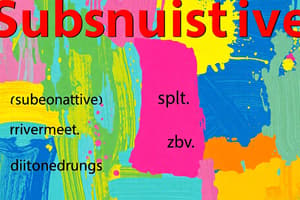Podcast
Questions and Answers
Match the following verb moods with their primary functions:
Match the following verb moods with their primary functions:
Subjunctive Mood = Describe hypothetical or uncertain situations Imperative Mood = Issue instructions or orders Conditional Mood = Express conditions or possibilities Declarative Mood = State facts
Match the following types of subjunctive verb forms with their descriptions:
Match the following types of subjunctive verb forms with their descriptions:
Present subjunctive = Verbs in infinitive form (e.g., 'I suggest you be quiet.') Past subjunctive = Verbs identical to simple past forms (e.g., 'I suggest he went home.') Future subjunctive = Verbs indicating hypothetical future events Indicative mood = Used to make statements or ask questions
Match the following real-life contexts with the appropriate use of subjunctive mood:
Match the following real-life contexts with the appropriate use of subjunctive mood:
Legal scenarios = Discussing hypothetical situations and uncertain outcomes Cooking instructions = Providing step-by-step guidance without room for negotiation Medical reports = Explaining factual medical conditions Historical documentaries = Narrating past events with certainty
Match the following verb moods with their common sentence structures:
Match the following verb moods with their common sentence structures:
Match the following descriptions with the correct mood they refer to:
Match the following descriptions with the correct mood they refer to:
Flashcards are hidden until you start studying
Study Notes
Verb Moods: Understanding Subjunctive, Imperative, and Conditional Moods
Verb moods are essential parts of English grammar that help express different attitudes, intentions, or realities related to the actions described by verbs. In this article, we delve deeper into three common verb moods: subjunctive, imperative, and conditional moods.
Subjunctive Mood
The subjunctive mood is used to describe hypothetical, contrary to fact, or uncertain situations. It often appears in sentences expressing wishes, suggestions, or commands. Unlike the declarative mood, which states facts, the subjunctive mood deals with propositions that are not actual.
There are two main types of subjunctive verb forms:
- Present subjunctive: Verbs in the present subjunctive take the infinitive form, such as "I suggest you be quiet."
- Past subjunctive: Verbs in the past subjunctive are identical to their simple past forms, like "I suggest he went home."
The subjunctive mood is particularly important in legal contexts where lawyers may need to discuss hypothetical scenarios, assess consequences, and convey conditions that rely on uncertain outcomes.
Imperative Mood
The imperative mood is used to issue instructions, orders, or directives. It typically takes the form of the main verb in the imperative form, which is the bare infinitive following the verb "to," such as "Don't forget to brush your teeth." The imperative mood is often categorized into two groups based on whether it commands actions to be done or not to do them.
Conditional Mood
The conditional mood expresses events that are dependent on certain conditions or circumstances. It helps convey hypothetical situations and their potential outcomes. There are five main types of conditional moods in English:
- Zero conditional: Expresses general truths or facts, such as "If I touch fire, my hand will burn."
- First conditional: Describes possible future events with real probability, like "If it rains tomorrow, we'll stay home."
- Second conditional: Deals with hypothetical situations with an unreal condition, such as "If I had money, I would buy a house."
- Third conditional: Discusses past or present events with an unfulfilled condition, like "If I had known earlier, I would have come sooner."
- Fourth conditional: Expresses hypothetical future situations with an unreal condition or past reality, such as "If I had a time machine, I could change history."
In conclusion, understanding these verb moods is crucial for effective communication in various contexts. The subjunctive mood helps express wishes and uncertainty; the imperative mood commands actions or directives; while the conditional mood deals with hypothetical scenarios that may or may not occur based on specific conditions.
Studying That Suits You
Use AI to generate personalized quizzes and flashcards to suit your learning preferences.




